Known as “Australia’s Galapagos Islands,” Christmas Island is a small, rocky outcrop in the northern Indian Ocean about 1,500 miles (2,500 km) northwest of Perth. What it lacks in size, it makes up for in biodiversity. As you approach via airplane, you’ll see its steep volcanic coastline and lush green foliage rising from a turquoise sea. Visitors know that scuba diving Christmas Island will be special even before you land.
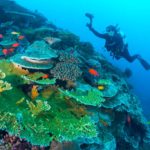

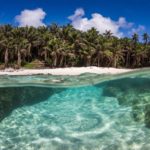


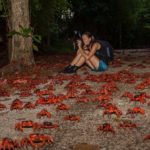
You’ll spend time underwater exploring the pristine fringing reef, its resident reef creatures and visiting pelagics such as mantas, schools of eagle rays and silky sharks. Whale sharks and pods of spinner dolphins are frequent visitors as well.
When you’re not underwater, follow one of the many hiking trails that wind through tropical rainforest. Discover hidden dales, waterfalls, grottos, caves and deserted beaches. Search among the winding roots of the giant fig trees for the island’s endemic land crabs and on the rocky outcrops and tree tops for endemic seabirds.
Scuba diving Christmas Island
The marine inhabitants of any diving destination are defined by its terrain and location. Christmas Island scores high on both counts, sitting atop an extinct, steep- sided volcano that rises almost four miles (6,000 m) from the sea floor below and located 186 miles (300 km) south of Java in the Indian Ocean.
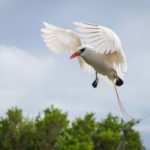



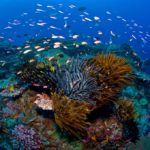

Ten degrees south of the equator, with abundant sunshine and nutrient-rich up-wellings, Christmas Islands’ steep-sided walls are covered in pristine coral reefs down to around 100 feet (20 or 30 m), where great gorgonian sea fans take over. These conditions are perfect for all kinds of fish, with 650 identified species making a home here.
What you’ll see
These steep-sided walls allow deep-water pelagics to near the island’s shoreline, and divers often have exceptional encounters with oceangoing manta rays, scalloped hammerhead sharks and whale sharks.
You’ll also see great shoals of parrotfish, surgeonfish and unicornfish working their way along the corals on every dive. On the near-vertical walls, the fusiliers stream up and down in search of plankton, and in the pocillopora coral heads, humbugs and hawkfish play hide and seek with divers as they pass.
Dive sites encircle the island and not all are steep walls. Some of the bays have shallow reefs sloping down to the drop-off and there are also caverns and caves weaving through the volcanic rock and coming out into the ocean below the waterline.
There is no urban pollution from the island and, being 186 miles (300 km) from any neighbor means that the waters are exceptionally clear, with visibility of at least 60 feet (18 m).
You can dive Christmas Island year-round as the waters are warm (around 26-29°C). There’s very little current and there’s always a lee shore somewhere if the wind is blowing. Two full service dive centers offer boat and shore dives daily, as well as the full gamut of training courses and gear rental.
Signature dive sites
Where your dive guide takes you will always depend on the day’s conditions, but rest assured that any site is good on Christmas Island. Spend a few days here, however, and you’ll surely visit these signature dive sites.
Perpendicular Wall
As the name implies, Perpendicular Wall is completely perpendicular to the ocean’s surface. It falls away almost vertically a few feet from the surface, the corals leaning out as far as they can to catch the sunlight. It’s a riot of color, with large gorgonian fans and walls teeming with fusiliers.
Flying Fish Cove
Christmas Island’s Flying Fish Cove rates as one of the best shore dives in the world. And you can do it easily on your own, by renting a tank from one of the local dive operators. The site is more or less in the center of town. You’ll step into the turquoise water from the beach of the boat ramp, and within a few feet pristine coral gardens will surround you.
Thundercliff Cave
There is, in fact, more than just one cave at this site — it’s a system of caves that divers can follow deep inside the island, although most will only visit the first two. There’s a big, open chamber with lovely blue light at the entrance and a second cave, featuring impressive stalactites and stalagmites.
Whale-shark encounters

Whale sharks frequent the reefs surrounding Christmas Island between November and April to feast on the red crab larvae that floods the water each year during the annual great red-crab migration. So, if you visit over Christmas, chances of an encounter are high.
Getting there
You can fly to Christmas Island from Perth (twice weekly) or Jakarta (weekly). Occasional charter services are also available from Kuala Lumpur. Check the Christmas Island Tourism Association website for more information.
Deborah Dickson-Smith is one half of Diveplanit, a dive travel website she manages with her partner Simon Mallender, based in Australia.
The post Scuba Diving Christmas Island appeared first on Scuba Diver Life.
from Scuba Diver Life https://ift.tt/2GFbK9p
No comments:
Post a Comment